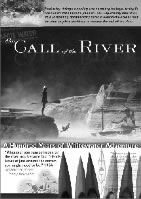A Hundred Years of Whitewater Adventure
Produced by Kent Ford (2008 Whitewater Hall of Fame Inductee)
93 Minutes
Performance Video. Durango, Colorado – 2009
Reviewed by Mike Rosso
Most Central Colorado residents are familiar with FIBArk, the big whitewater festival held every summer in Salida. What they may not be aware of is the event’s impact on the sport of whitewater boating in the United States.
Renowned paddler and filmmaker Kent Ford brings that history to life with his new film, Call of the River, which traces the origins of the sport of river running from early canoeing adventures to modern creek boating.

Ford, a long-standing former member of the US Whitewater Team, three time National Champion, and two time C-1 slalom team World Champion, showed his new film during the 60th FIBArk (First in Boating on the Arkansas River) festival this June – an especially appropriate venue considering how the early days of the event became the linchpin for the growth in popularity of the sport nationally.
By 1949, whitewater kayaking had already established itself as a major outdoor sport in Europe, but in the U.S., river running was limited to small groups of brave souls on the East and West coasts. The first American boat races, held that year in Salida, changed everything. Using wonderful, rare archival footage from the early days of the event, Call of the River depicts elaborate parades down F Street featuring international boat racers. It also captures scenes of large crowds assembled along the banks of the Arkansas River east of town to view the downriver races, many of them having ridden the train to spectator spots along the river. Early color footage of the races themselves are also featured, creating an amazing visual peek into Salida’s past.
It was these early races featuring top European boaters that grabbed the national spotlight and put whitewater racing, and Salida, on the map. Ford’s use of narration, old footage and interviews with pioneers of the sport give the viewer a thought provoking and often humorous look at the evolution of the sport from canvas-stretched wood frame canoes to modern plastic kayaks.
The film is well-researched and provides surprises even for those who consider themselves avid boaters. For example, the film reveals how early kayakers in this country literally had to build their own fiberglass boats due to the prohibitive cost of manufactured ones. We also learn the aluminum canoe came about during the latter years of World War II as the Grumman Aircraft Engineering Corporation shifted their production from aluminum fighter aircraft to a new concept — aluminum canoes, recognizing the growing interest in the sport and the need to retool their factories for the post-war economy, selling up to 10,000 boats annually by the early 1950s.
Early footage of boaters struggling with aluminum canoes wrapped around rocks in moving water help the viewer understand the need for development of stronger hull materials such as polyethylene and Royalex.
Filming of Call of the River began in 1998 with the first interviews taking place at the 50th FIBArk festival. Ford then put the project on hold for a variety of reasons but started again in earnest in 2006. He said the idea for the film came about after seeing other sports documentaries such as Fire on the Mountain, about the 10th Mountain Army Division. Knowing that historical footage of whitewater boating existed, he set about digging up old films from museums and private collections. The Salida Museum provided much of the early FIBArk footage.
Interviews were conducted in six different phases throughout the country.
The film is recommended for anyone who enjoys running rivers – from casual recreationalists to hardcore whitewater enthusiasts – and is of particular interest to Central Colorado residents curious about seeing the past come alive on the screen and recognizing the impact Salida had on the popularization of the sport of kayaking nationally.
The film can be purchased from the website: www.performancevideo.com/The_Call_of_the_River which also features a nifty preview of the film. Ford is also hoping to have the film distributed through a major studio in the near future.



